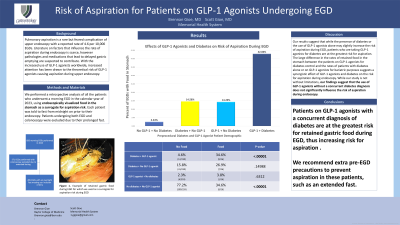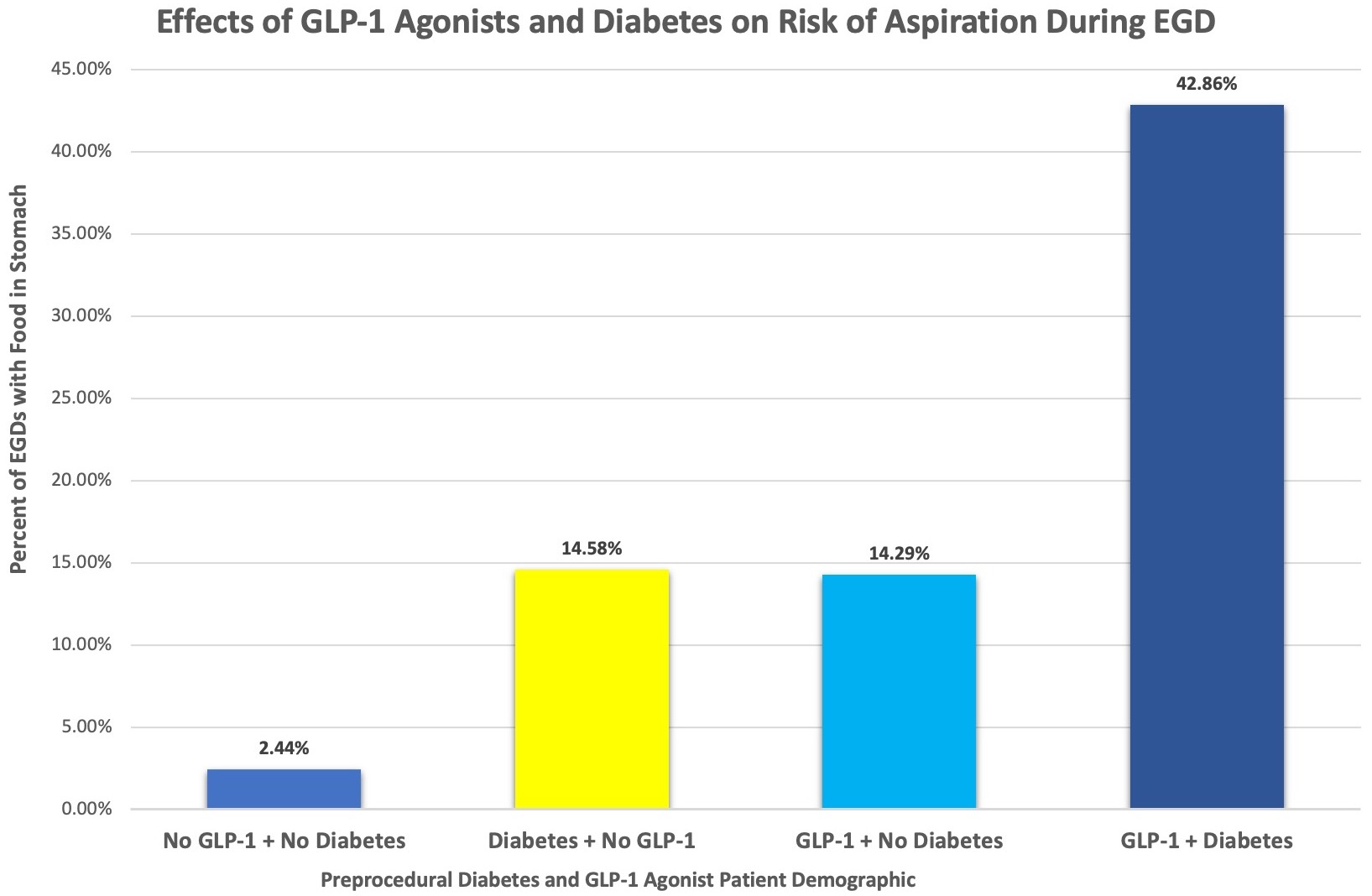Monday Poster Session
Category: General Endoscopy
P2376 - Risk of Aspiration for Patients on GLP-1 Agonists Undergoing EGD
Monday, October 28, 2024
10:30 AM - 4:00 PM ET
Location: Exhibit Hall E

Has Audio
- BG
Brennan Gioe, MD
Baylor College of Medicine
Houston, TX
Presenting Author(s)
Brennan Gioe, MD1, Scott Gioe, MD2
1Baylor College of Medicine, Houston, TX; 2Gastroenterology Center PA, Gulfport, MS
Introduction: Pulmonary aspiration is a rare but feared complication of upper endoscopy with a reported rate of 4.6 per 10,000 EGDs. Literature on factors that influence the rate of aspiration during endoscopy is scarce, however pathologies and medications that lead to delayed gastric emptying are suspected to contribute. With the increased use of GLP-1 agonists worldwide, increased attention has been drawn to the theoretical risk of GLP-1 agonists causing aspiration during upper endoscopy.
Methods: We performed a retrospective analysis of all the patients at our endoscopy center who underwent a morning EGD performed by a single endoscopist in the calendar year of 2023. 571 patients undergoing both EGD and colonoscopy were excluded due to their prolonged fast. We used endoscopically visualized food in the stomach as a surrogate for aspiration risk. Each patient was told to fast from midnight on prior to their endoscopy. We separated our population into a “food” group or a “no food” group and statistically compared these two groups using a Z-test.
Results: Of the 285 EGDs reviewed, 26 had retained gastric food (9%). We found that 43% of patients with GLP-1 agonist use with concurrent diabetes (DM) had retained gastric food (RGF). Only 14.3 % of patients with GLP-1 agonist use and no diabetes had RGF. 14.6% of patients with DM and no GLP-1 use, and 2.2% of patients with no GLP-1 agonist use and no DM were found to have RGF. When comparing the group of patients with RGF to those without RGF, there was a significantly higher percent of patients with GLP-1 agonist use with concurrent DM (35% vs 5%, p< .00001). The two groups did not significantly differ when comparing DM without GLP-1 agonist use (27% vs 16%, p=.1499) or GLP-1 agonist use without DM (3.8% vs 2.3%, p=.6312).
Discussion: Patients on GLP-1 agonists with a concurrent diagnosis of diabetes are at the greatest risk for retained gastric food in the stomach during EGD. We recommend extra pre-EGD precautions to prevent aspiration in these patients, such as an extended fast.
While larger studies are warranted, there is not enough evidence at this time to suggest that GLP-1 agonists alone or a diagnosis of diabetes alone significantly effect the rate of retained gastric food and therefore aspiration risk during upper endoscopy.

Note: The table for this abstract can be viewed in the ePoster Gallery section of the ACG 2024 ePoster Site or in The American Journal of Gastroenterology's abstract supplement issue, both of which will be available starting October 27, 2024.
Disclosures:
Brennan Gioe, MD1, Scott Gioe, MD2. P2376 - Risk of Aspiration for Patients on GLP-1 Agonists Undergoing EGD, ACG 2024 Annual Scientific Meeting Abstracts. Philadelphia, PA: American College of Gastroenterology.
1Baylor College of Medicine, Houston, TX; 2Gastroenterology Center PA, Gulfport, MS
Introduction: Pulmonary aspiration is a rare but feared complication of upper endoscopy with a reported rate of 4.6 per 10,000 EGDs. Literature on factors that influence the rate of aspiration during endoscopy is scarce, however pathologies and medications that lead to delayed gastric emptying are suspected to contribute. With the increased use of GLP-1 agonists worldwide, increased attention has been drawn to the theoretical risk of GLP-1 agonists causing aspiration during upper endoscopy.
Methods: We performed a retrospective analysis of all the patients at our endoscopy center who underwent a morning EGD performed by a single endoscopist in the calendar year of 2023. 571 patients undergoing both EGD and colonoscopy were excluded due to their prolonged fast. We used endoscopically visualized food in the stomach as a surrogate for aspiration risk. Each patient was told to fast from midnight on prior to their endoscopy. We separated our population into a “food” group or a “no food” group and statistically compared these two groups using a Z-test.
Results: Of the 285 EGDs reviewed, 26 had retained gastric food (9%). We found that 43% of patients with GLP-1 agonist use with concurrent diabetes (DM) had retained gastric food (RGF). Only 14.3 % of patients with GLP-1 agonist use and no diabetes had RGF. 14.6% of patients with DM and no GLP-1 use, and 2.2% of patients with no GLP-1 agonist use and no DM were found to have RGF. When comparing the group of patients with RGF to those without RGF, there was a significantly higher percent of patients with GLP-1 agonist use with concurrent DM (35% vs 5%, p< .00001). The two groups did not significantly differ when comparing DM without GLP-1 agonist use (27% vs 16%, p=.1499) or GLP-1 agonist use without DM (3.8% vs 2.3%, p=.6312).
Discussion: Patients on GLP-1 agonists with a concurrent diagnosis of diabetes are at the greatest risk for retained gastric food in the stomach during EGD. We recommend extra pre-EGD precautions to prevent aspiration in these patients, such as an extended fast.
While larger studies are warranted, there is not enough evidence at this time to suggest that GLP-1 agonists alone or a diagnosis of diabetes alone significantly effect the rate of retained gastric food and therefore aspiration risk during upper endoscopy.

Figure: Effects of GLP-1 Agonists and Diabetes on Risk of Aspiration During EGD
Note: The table for this abstract can be viewed in the ePoster Gallery section of the ACG 2024 ePoster Site or in The American Journal of Gastroenterology's abstract supplement issue, both of which will be available starting October 27, 2024.
Disclosures:
Brennan Gioe indicated no relevant financial relationships.
Scott Gioe indicated no relevant financial relationships.
Brennan Gioe, MD1, Scott Gioe, MD2. P2376 - Risk of Aspiration for Patients on GLP-1 Agonists Undergoing EGD, ACG 2024 Annual Scientific Meeting Abstracts. Philadelphia, PA: American College of Gastroenterology.
